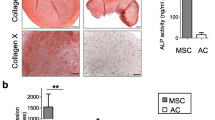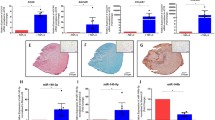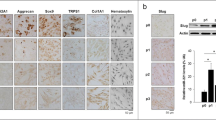Abstract
Generating appropriate cartilage for clinical applications to heal skeletal tissue loss is a major health concern. In this regard, cell-based approaches offer a potential therapeutic strategy for cartilage repair, although little is known about the precise mechanism of chondrogenesis. Unrestricted somatic stem cell (USSC) is considered as a suitable candidate because of its potential for differentiating into multiple cell types. Recent studies show that microRNAs (miRNAs) are involved in several biological processes including development and differentiation. To identify the chondro-specific miRNA signature, miRNA patterns of USSCs and differentiated chondrocytes were investigated using microarrays and validation by qPCR. Prior to these analyses, chondrogenic commitment of differentiated USSCs was verified by immunocytochemistry, specific staining and evaluation of some main chondrogenic marker genes. Various in silico explorations (for both putative targets and signalling pathways) and empirical analyses (miRNA transfections followed by qPCR of some chondrogenic indicators) were carried out to support our results. Transient modulation of multiple chondro-miRs (such as mir-630, mir-624 and mir-376) with chondrocyte targets (such as TGFbR, MAP3K, collagens, SMADs and cadherins) as mediators of chondrogenic signalling pathways including cell–cell interactions, TGF-beta, and MAPK signalling suggests a mechanism for genetic induction of chondrogenic differentiation. In conclusion, this research reveals more details about the allocation of USSCs into the chondrocytes through identification of miRNA signature which modulates targets and pathways required for chondrogenic lineage and could provide guidelines for future clinical treatments and anti-miRNA therapies.




Similar content being viewed by others
References
Akhtar N., Rasheed Z., Ramamurthy S., Anbazhagan A. N., Voss F. R. and Haqqi T. M. 2010 MicroRNA-27b regulates the expression of matrix metalloproteinase 13 in human osteoarthritis chondrocytes. Arthritis Rheum. 62, 1361–1371.
Akiyama H., Lyons J. P., Mori-Akiyama Y., Yang X., Zhang R., Zhang Z. et al. 2004 Interactions between Sox9 and beta-catenin control chondrocyte differentiation. Genes Dev. 18, 1072– 1087.
Arnsdorf E. J., Tummala P. and Jacobs C. R. 2009 Non-canonical Wnt signaling and N-cadherin related beta-catenin signaling play a role in mechanically induced osteogenic cell fate. PLoS ONE 4, e5388.
Babak T., Zhang W., Morris Q., Blencowe B. J. and Hughes T. R. 2004 Probing microRNAs with microarrays: tissue specificity and functional inference. RNA 10, 1813–1819.
Bakhshandeh B., Soleimani M., Ghaemi N. and Shabani I. 2011 Effective combination of aligned nanocomposite nanofibers and human unrestricted somatic stem cells for bone tissue engineering. Acta Pharmacol. Sin. 32, 626–636.
Bakhshandeh B., Soleimani M., Hafizi M., Paylakshi S.H. and Ghaemi N. 2012a MicroRNA signatures associated with osteogenic lineage commitment. Mol. Biol. Rep. 39, 7569–7581.
Bakhshandeh B., Soleimani M., Hafizi M. and Ghaemi N. 2012b A comparative study on nonviral genetic modifications in cord blood and bone marrow mesenchymal stem cells. Cytotechnology (in press).
Bakhshandeh B., Hafizi M., Ghaemi N. and Soleimani M. 2012c Down-regulation of miRNA-221 triggers osteogenic differentiation in human stem cells. Biotechnol. Lett. 34, 1579–1587.
Bartel D. P. 2004 MicroRNAs: genomics, biogenesis, mechanism, and function. Cell 116, 281–297.
Beier F. and Loeser R. F. 2010 Biology and pathology of Rho GTPase, PI-3 kinase-Akt, and MAP kinase signaling pathways in chondrocytes. J. Cell. Biochem. 110, 573–580.
Bentwich I. 2005 Prediction and validation of microRNAs and their targets. FEBS Lett. 579, 5904–5910.
Betel D., Wilson M., Gabow A., Marks D. S. and Sander C. 2008 The microRNA.org resource: targets and expression. Nucleic Acids Res. 36, 149–153.
Blaney Davidson E. N., Scharstuhl A., Vitters E. L., van der Kraan P. M. and van den Berg W. B. 2005 Reduced transforming growth factor-beta signaling in cartilage of old mice: role in impaired repair capacity. Arthritis Res. Ther. 7, 1338–1347.
Briggs M. D., Rasmussen I. M., Weber J. L., Yuen J., Reinker K., Garber A. P. et al. 1993 Genetic linkage of mild pseudoachondroplasia (PSACH) to markers in the pericentromeric region of chromosome 19. Genomics 18, 656–660.
Caerteling S. B., van der Kraan P. M., Vitters E. L., Dechering K. J., van Zoelen E. J. and Piek E. 2011 Article withdrawn prior to final publication. Inhibition of JNK enhances chondrogenesis of mesenchymal progenitor cells by increasing autocrine TGFbeta signaling. Arthritis Rheum. 63, 849.
Caldas J. and Kaski S. 2011 Hierarchical generative biclustering for microrna expression analysis. J. Comput. Biol. 18, 251–261.
Canales R. D., Luo Y., Willey J. C., Austermiller B., Barbacioru C. C., Boysen C. et al. 2006 Evaluation of DNA microarray results with quantitative gene expression platforms. Nat. Biotechnol. 24, 1115–1122.
Davison T. S., Johnson C. D. and Andruss B. F. 2006 Analyzing micro-RNA expression using microarrays. Methods Enzymol. 411, 14–34.
Dong Y., Jesse A. M., Kohn A., Gunnell L. M., Honjo T., Zuscik M. J. et al. 2010 RBPjkappa-dependent Notch signaling regulates mesenchymal progenitor cell proliferation and differentiation during skeletal development. Development 137, 1461– 1471.
Dudek K. A., Lafont J. E., Martinez-Sanchez A. and Murphy C. L. 2010 Type II collagen expression is regulated by tissue-specific miR-675 in human articular chondrocytes. J. Biol. Chem. 285, 24381–24387.
Dunn W., DuRaine G. and Reddi A. H. 2009 Profiling microRNA expression in bovine articular cartilage and implications for mechanotransduction. Arthritis Rheum. 60, 2333–2339.
Fazi F. and Nervi C. 2008 MicroRNA: basic mechanisms and transcriptional regulatory networks for cell fate determination. Cardiovasc. Res. 79, 553–561.
Freyria A. M. and Mallein-Gerin F. 2011 Chondrocytes or adult stem cells for cartilage repair: The indisputable role of growth factors. Injury 43, 259–265.
Gentleman R. C., Carey V. J., Bates D. M., Bolstad B., Dettling M., Dudoit S. et al. 2004 Bioconductor: open software development for computational biology and bioinformatics. Genome Biol. 5, 80.
Goldring M. B., Tsuchimochi K. and Ijiri K. 2006 The control of chondrogenesis. J. Cell. Biochem. 97, 33–44.
Hiyama A., Gogate S. S., Gajghate S., Mochida J., Shapiro I. M. and Risbud M. V. 2010 BMP-2 and TGF-beta stimulate expression of beta1,3-glucuronosyl transferase 1 (GlcAT-1) in nucleus pulposus cells through AP1, TonEBP, and Sp1: role of MAPKs. J. Bone Miner. Res. 25, 1179–1190.
Huang J., Zhao L., Xing L. and Chen D. 2010 MicroRNA-204 regulates Runx2 protein expression and mesenchymal progenitor cell differentiation. Stem Cells 28, 357–364.
Karlsson C. and Lindahl A. 2009 Notch signaling in chondrogenesis. Int. Rev. Cell Mol. Biol. 275, 65–88.
Karlsson C., Jonsson M., Asp J., Brantsing C., Kageyama R. and Lindahl A. 2007 Notch and HES5 are regulated during human cartilage differentiation. Cell Tissue Res. 327, 539–551.
Keller B., Yang T., Chen Y., Munivez E., Bertin T., Zabel B. and Lee B. 2011 Interaction of TGFbeta and BMP signaling pathways during chondrogenesis. PLoS ONE 6, e16421.
Kim D., Song J. and Jin E. J. 2010 MicroRNA-221 regulates chondrogenic differentiation through promoting proteosomal degradation of slug by targeting Mdm2. J. Biol. Chem. 285, 26900–26907.
Kogler G., Sensken S., Airey J. A., Trapp T., Muschen M., Feldhahn N. et al. 2004 A new human somatic stem cell from placental cord blood with intrinsic pluripotent differentiation potential. J. Exp. Med. 200, 123–135.
Lai K. W., Koh K. X., Loh M., Tada K., Subramaniam M. M., Lim X. Y. et al. 2010 MicroRNA-130b regulates the tumour suppressor RUNX3 in gastric cancer. Eur. J. Cancer 46, 1456– 1463.
Li J., Zhao Z., Liu J., Huang N., Long D., Wang J. et al. 2010 MEK/ERK and p38 MAPK regulate chondrogenesis of rat bone marrow mesenchymal stem cells through delicate interaction with TGF-beta1/Smads pathway. Cell Prolif. 43, 333–343.
Lin E. A., Kong L., Bai X. H., Luan Y. and Liu C. J. 2009 miR-199a, a bone morphogenic protein 2-responsive MicroRNA, regulates chondrogenesis via direct targeting to Smad1. J. Biol. Chem. 284, 11326–11335.
Lossner C., Meier J., Warnken U., Rogers M. A., Lichter P., Pscherer A. and Schnolzer M. 2011 Quantitative proteomics identify novel miR-155 target proteins. PLoS ONE 6, e22146.
Mizuta H., Sanyal A., Fukumoto T., Fitzsimmons J. S., Matsui N., Bolander M. E. et al. 2002 The spatiotemporal expression of TGF-beta1 and its receptors during periosteal chondrogenesis in vitro. J. Orthop. Res. 20, 562–574.
Nilsen T. W. 2007 Mechanisms of microRNA-mediated gene regulation in animal cells. Trends Genet. 23, 243–249.
Ohgawara T., Kubota S., Kawaki H., Kondo S., Eguchi T., Kurio N. et al. 2009 Regulation of chondrocytic phenotype by micro RNA 18a: involvement of Ccn2/Ctgf as a major target gene. FEBS Lett. 583, 1006–1010.
Oldershaw R. A. and Hardingham T. E. 2010 Notch signaling during chondrogenesis of human bone marrow stem cells. Bone 46, 286–293.
Oldershaw R. A., Tew S. R., Russell A. M., Meade K., Hawkins R., McKay T. R. et al. 2008 Notch signaling through Jagged-1 is necessary to initiate chondrogenesis in human bone marrow stromal cells but must be switched off to complete chondrogenesis. Stem Cells 26, 666–674.
Paassilta P., Lohiniva J., Annunen S., Bonaventure J., Le Merrer M., Pai L. and Ala-Kokko L. 1999 COL9A3: A third locus for multiple epiphyseal dysplasia. Am. J. Hum. Genet. 64, 1036– 1044.
Ren J., Jin P., Wang E., Marincola F. M. and Stroncek D. F. 2009 MicroRNA and gene expression patterns in the differentiation of human embryonic stem cells. J. Transl. Med. 7, 20.
Saini H. K., Griffiths-Jones S. and Enright A. J. 2007 Genomic analysis of human microRNA transcripts. Proc. Natl. Acad. Sci. USA 104, 17719–17724.
Schoolmeesters A., Eklund T., Leake D., Vermeulen A., Smith Q., Force Aldred S. and Fedorov Y. 2009 Functional profiling reveals critical role for miRNA in differentiation of human mesenchymal stem cells. PLoS ONE 4, e5605.
Smyth G. K. 2004 Linear models and empirical bayes methods for assessing differential expression in microarray experiments. Stat. Appl. Genet. Mol. Biol. 3, Article3.
Sorrentino A., Ferracin M., Castelli G., Biffoni M., Tomaselli G., Baiocchi M. et al. 2008 Isolation and characterization of CD146+ multipotent mesenchymal stromal cells. Exp. Hematol. 36, 1035–1046.
Sturn A., Quackenbush J. and Trajanoski Z. 2002 Genesis: cluster analysis of microarray data. Bioinformatics 18, 207–208.
Suomi S., Taipaleenmaki H., Seppanen A., Ripatti T., Vaananen K., Hentunen T. et al. 2008 MicroRNAs regulate osteogenesis and chondrogenesis of mouse bone marrow stromal cells. Gene Regul. Syst. Biol. 2, 177–191.
Tiller G. E., Hannig V. L., Dozier D., Carrel L., Trevarthen K. C., Wilcox W. R. et al. 2001 A recurrent RNA-splicing mutation in the SEDL gene causes X-linked spondyloepiphyseal dysplasia tarda. Am. J. Hum. Genet. 68, 1398–1407.
Tuddenham L., Wheeler G., Ntounia-Fousara S., Waters J., Hajihosseini M. K., Clark I. and Dalmay T. 2006 The cartilage specific microRNA-140 targets histone deacetylase 4 in mouse cells. FEBS Lett. 580, 4214–4217.
Wang X. 2006 Systematic identification of microRNA functions by combining target prediction and expression profiling. Nucleic Acids Res. 34, 1646–1652.
Wiemer E. A. 2007 The role of microRNAs in cancer: no small matter. Eur. J. Cancer 43, 1529–1544.
Wrana J. L., Attisano L., Wieser R., Ventura F. and Massague J. 1994 Mechanism of activation of the TGF-beta receptor. Nature 370, 341–347.
Wu X. and Watson M. 2009 CORNA: testing gene lists for regulation by microRNAs. Bioinformatics 25, 832–833.
Wu Z. L., Prather B., Ethen C. M., Kalyuzhny A. and Jiang W. 2011 Detection of specific glycosaminoglycans and glycan epitopes by in vitro sulfation using recombinant sulfotransferases. Glycobiology 21, 625–633.
Zhou S., Eid K. and Glowacki J. 2004 Cooperation between TGF-beta and Wnt pathways during chondrocyte and adipocyte differentiation of human marrow stromal cells. J. Bone Mineral Res. 19, 463–470.
Zuntini M., Salvatore M., Pedrini E., Parra A., Sgariglia F., Magrelli A. et al. 2010 MicroRNA profiling of multiple osteochondromas: identification of disease-specific and normal cartilage signatures. Clin. Genet. 78, 507–516.
Acknowledgements
This work was financially supported by Stem Cell Technology Research Center, Tehran, Iran. We thank Mr Seyed Zarvan Shahrzad for his contribution in English writing.
Author information
Authors and Affiliations
Corresponding author
Additional information
Bakhshandeh B., Soleimani M., Paylakhi S. H. and Ghaemi N. 2012 A microRNA signature associated with chondrogenic lineage commitment. J. Genet. 91, xx–xx
Electronic Supplementary Material
Below is the link to the electronic supplementary material.
Rights and permissions
About this article
Cite this article
BAKHSHANDEH, B., SOLEIMANI, M., PAYLAKHI, S.H. et al. A microRNA signature associated with chondrogenic lineage commitment. J Genet 91, 171–182 (2012). https://doi.org/10.1007/s12041-012-0168-0
Received:
Revised:
Accepted:
Published:
Issue Date:
DOI: https://doi.org/10.1007/s12041-012-0168-0




